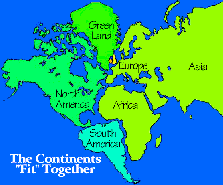

 |
Plate Tectonics & Heat Flow Almost since the
creation of the first accurate maps of the eastern coasts of the Americas and the western
coasts of Europe and Africa, people have noticed that the two coastlines nearly
"fit" together. In the late 1960s, it was acknowledged that, in fact, the whole lithosphere
of the earth is like a giant jigsaw puzzle, consisting of small and large pieces, called
plates, joined at the edges by huge cracks, faults, and deep trenches. Incredibly, the
individual plates are moving in different directions across the surface of the earth. The
movement of the plates is very slow, only a few centimeters a year (about the speed at
which your fingernails grow), but the consequences are enormous for all of us. Think for a
moment. If huge chunks of the earth's surface are moving in different directions, they
must be ripping apart in some places and crunching together in others. Almost since the
creation of the first accurate maps of the eastern coasts of the Americas and the western
coasts of Europe and Africa, people have noticed that the two coastlines nearly
"fit" together. In the late 1960s, it was acknowledged that, in fact, the whole lithosphere
of the earth is like a giant jigsaw puzzle, consisting of small and large pieces, called
plates, joined at the edges by huge cracks, faults, and deep trenches. Incredibly, the
individual plates are moving in different directions across the surface of the earth. The
movement of the plates is very slow, only a few centimeters a year (about the speed at
which your fingernails grow), but the consequences are enormous for all of us. Think for a
moment. If huge chunks of the earth's surface are moving in different directions, they
must be ripping apart in some places and crunching together in others.
Characteristic geologic features are found at the edges of plates. Where the plates are separating on ocean floors, there are oceanic ridges. These comprise a set of long, broad ridges snaking about the earth. Each ridge has a small, narrow canyon running along its crest. The sides of the small canyons are huge faults or cracks. Small amounts of basaltic lava are continuously erupting along these and other cracks in the canyon floor to fill in the gaps made by the separating plates. Where plates are separating on land, there are long canyons with faulted sides called rifts. The Kenya rift in Africa and the Rio Grande Rift in New Mexico are examples of these. Where the plates are colliding, there are either huge mountain ranges, such as the Himalayas in India (on land), or incredibly deep trenches (in the ocean) such as the Kermadek Trench near New Zealand. In the distant past, continental crashes formed mountain ranges like the Rockies and Appalachians. Volcanoes commonly occur along colliding plate boundaries. The nearly continuous band of volcanoes around the edges of the Pacific Ocean, evidence of "continental crunch" around the entire Pacific plate, is called the Ring of Fire. In some places, like Southern California, the plates are neither colliding nor separating, but are simply sliding past each other. In these cases, there are great big cracks or faults (like the San Andreas in California). Unfortunately, the sliding is not smooth, but sticky and jerky. To the minuscule beings living on the "rubbing shoulders" of the gargantuan Pacific and North American plates, these tiny stops and starts are huge earthquakes that cause endless problems.
[ Locations of Volcanoes ] [ Home ] [ Teacher Pages ] [ Modules & Activities ] |
HTML code by Chris Kreger
Maintained by ETE Team
Last updated November 10, 2004
Some images © 2004 www.clipart.com
Privacy Statement and Copyright © 1997-2004 by Wheeling Jesuit University/NASA-supported Classroom of the Future. All rights reserved.
Center for Educational Technologies, Circuit Board/Apple graphic logo, and COTF Classroom of the Future logo are registered trademarks of Wheeling Jesuit University.